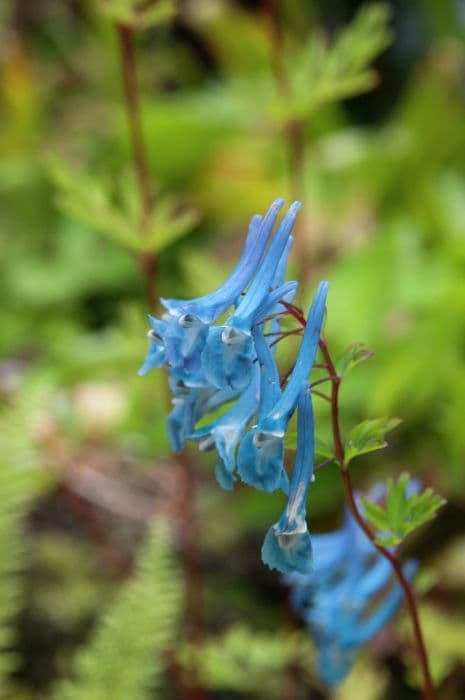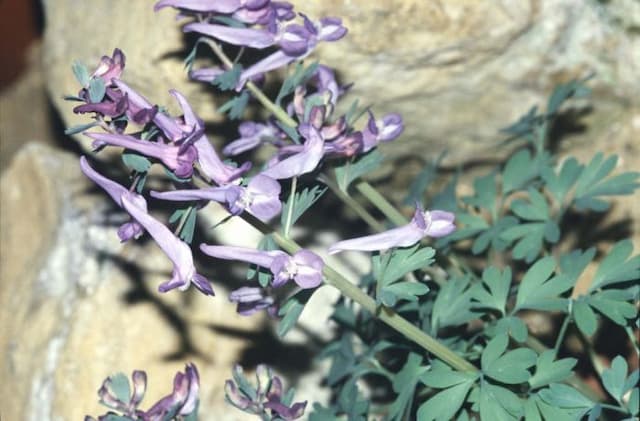Himalayan Blue Poppy Meconopsis (Infertile Blue Group) 'Crewdson Hybrid'

ABOUT
The Meconopsis, commonly known as the Himalayan Blue Poppy, 'Crewdson Hybrid' is a visually striking plant renowned for its beautiful flowering display. This cultivar is noted for its large, satiny petals that exude a radiant sky blue hue, often with a slight purplish tint. At the center of each blossom, there is a cluster of yellow stamens that create a striking contrast against the blue petals, accentuating the plant's ornamental appeal. The leaves of the plant are mostly basal, forming a rosette shape that is typically lush and green, creating a pleasing backdrop to the flowers. Texturally, the foliage is sometimes hairy, which adds to the tactile interest of the plant. Although the specific dimensions of the plant are excluded, the 'Crewdson Hybrid' generally presents a bushy and rounded appearance, with a balance between its floral and foliar elements. The flowers themselves, well-known for their rarity and enchanting color, bloom on singular stems that rise above the foliage, each stem typically carrying a single magnificent flower. The vivid blue blooms are a sought-after spectacle in gardens due to their unique and vivid coloring, which is not very common among flowering plants. With proper care and under the right conditions, this hybrid variety can provide a captivating floral show that is both rare and delightful to observe.
About this plant
 Names
NamesFamily
Papaveraceae
Synonyms
Himalayan Blue Poppy, Blue Poppy
Common names
Meconopsis (Infertile Blue Group) 'Crewdson Hybrid'
 Toxicity
ToxicityTo humans
Blue poppies, including Meconopsis 'Crewdson Hybrid', are generally not known to be toxic to humans. There is limited information on their toxicity, and they are not commonly associated with poisoning or adverse effects if ingested. However, it is always advisable to avoid eating ornamental plants due to potential unknown hazards.
To pets
Blue poppies, including Meconopsis 'Crewdson Hybrid', are not specifically listed as toxic to pets. There is no widely-known documentation of toxicity in these plants concerning dogs, cats, or other domestic animals. As with their effects on humans, it's best to prevent pets from ingesting any part of ornamental plants to avoid any potential risks.
 Characteristics
CharacteristicsLife cycle
Perennials
Foliage type
Deciduous
Color of leaves
Green
Flower color
Blue
Height
3-4 feet (0.91-1.22 meters)
Spread
12-24 inches (30-60 centimeters)
Plant type
Herb
Hardiness zones
6
Native area
Himalayas
Benefits
 General Benefits
General Benefits- Aesthetic Appeal: Himalayan Blue Poppy adds a vivid splash of blue to a garden, which is relatively rare in flowering plants and can create stunning visual interest.
- Ornamental Value: With its striking blue blooms, this perennial plant is highly prized for its ornamental qualities and can elevate the design of any garden space.
- Pollinator Attraction: The vivid flowers can attract pollinators such as bees, which are essential for the pollination of many plants and support biodiversity.
- Garden Variety: Himalayan Blue Poppy can be used to introduce variety into a planting scheme, especially in shade gardens where it thrives.
- Seasonal Interest: It flowers from late spring to early summer, providing seasonal interest during a time when many other plants are also in peak bloom.
- Cool-Climate Adaptation: This plant is well-suited for cooler climates and higher altitudes, making it ideal for gardeners in such regions.
- Conservation: Cultivating Himalayan Blue Poppies can contribute to the conservation of a unique species, especially since some Meconopsis species are considered at risk in their natural habitats.
 Medical Properties
Medical PropertiesThis plant is not used for medical purposes.
 Air-purifying Qualities
Air-purifying QualitiesThis plant is not specifically known for air purifying qualities.
 Other Uses
Other Uses- Photography subjects: The striking blue of the Himalayan Blue Poppy makes it an exceptional subject for botanical photographers and artists seeking to capture its unique beauty.
- Garden color theme: Garden designers may use the Himalayan Blue Poppy to create a blue color-themed garden, which can be particularly peaceful and serene.
- Artistic inspiration: The intense blue color and the delicate nature of the flowers can inspire artists and designers, influencing their creations in various forms of art, from paintings to textiles.
- Educational tool: Botanists and educators may use this plant to help teach about the adaptability and evolution of alpine flowers in harsh mountain environments.
- Collector's item: Owing to its rarity and difficulty to grow, the Himalayan Blue Poppy is often sought after by plant collectors and enthusiasts to add to their private or public horticultural collections.
- Symbolic planting: In certain cultures or contexts, the Himalayan Blue Poppy might be planted to symbolize resilience or rarity, reflecting its survival in challenging Himalayan climates.
- Therapeutic landscapes: This plant can be incorporated into garden designs aimed at providing a therapeutic or calming environment, owing to its tranquil appearance.
- Bee attraction: Though it is sterile, the Himalayan Blue Poppy can still attract bees and other pollinators to gardens, contributing to the biodiversity of the area.
- Climate research: The Himalayan Blue Poppy can be part of climate change studies, considering its native habitat and potential impact on alpine plant growth patterns.
- Green roof planting: Some green roofs may incorporate Himalayan Blue Poppies for their visual appeal, assuming the environment can sustain their growth requirements.
Interesting Facts
 Feng Shui
Feng ShuiThe Himalayan Blue Poppy is not used in Feng Shui practice.
 Zodiac Sign Compitability
Zodiac Sign CompitabilityThe Himalayan Blue Poppy is not used in astrology practice.
 Plant Symbolism
Plant Symbolism- Rarity: The Meconopsis, commonly known as Blue Poppy, is a rare and sought-after plant, symbolizing the unique and the uncommon in life, as well as the pursuit of rare beauty.
- Peace: With its serene blue hues, the Blue Poppy signifies peace, tranquility, and a calming presence, reminding one of the quietude and majestic stillness of nature.
- Dreams: Due to its dreamlike appearance, the Blue Poppy is often associated with imagination and fantasy, representing the world of dreams and aspirations.
- Success: The difficulty in cultivating Blue Poppies has led to their association with success, particularly success after a struggle or challenge, as they are a testament to the gardener's skill and perseverance.
- Solitude: Blue Poppies can also symbolize solitude or the enjoyment of one's own company, as they are often found growing alone or in small clusters in their natural habitats.
 Water
WaterThe Himalayan blue poppy should be watered deeply and consistently, keeping the soil evenly moist but not waterlogged. Water the plant with about 1 inch of water once a week, adjusting for rainfall and temperature, which means roughly half a gallon for an average sized plant. During hot or windy weather, you may need to water more frequently to maintain the consistent moisture needed for optimal growth and bloom production. It is crucial to avoid letting the soil dry out completely, as this can be detrimental to the plant's health.
 Light
LightHimalayan blue poppies thrive in a spot with dappled sunlight or part shade, avoiding the intense heat of direct afternoon sun. The ideal location would provide morning sunlight with protection from strong midday and afternoon rays. They can also succeed in full shade, especially in hotter climates, but too little light may reduce flowering.
 Temperature
TemperatureThe Himalayan blue poppy prefers cooler conditions and does not thrive in extreme heat. The ideal temperature range is between 50°F and 70°F. These plants can survive minimum temperatures as low as 20°F, but they will struggle in temperatures above 80°F. Providing a cool, sheltered environment will help in maintaining the ideal temperature conditions for the plant.
 Pruning
PruningPruning the Himalayan blue poppy is primarily for the removal of spent flowers and dead or damaged foliage to maintain plant vigor and aesthetic appeal. Deadheading after blooms have spent encourages the plant to focus energy on foliage growth and potential new buds. Pruning should be done carefully with clean, sharp tools, and generally, it is not needed more than once a year, immediately after flowering is completed.
 Cleaning
CleaningAs needed
 Soil
SoilThe Blue Poppy thrives in a well-draining, humus-rich mix with a slightly acidic to neutral pH between 6.0 and 7.0. A suitable mix might include equal parts loam, leaf mold or peat, and perlite to ensure proper drainage and aeration.
 Repotting
RepottingBlue Poppies do not transplant well due to their delicate root systems and generally do not require frequent repotting. It is best to repot only when necessary, such as when outgrowing their current container or when soil is exhausted, potentially every 2-3 years.
 Humidity & Misting
Humidity & MistingThe Blue Poppy prefers high humidity levels, ideally between 50-70%. Regular misting can help maintain these humidity conditions without directly affecting their watering schedule.
 Suitable locations
Suitable locationsIndoor
Provide bright indirect light, cool temps, and high humidity for Blue Poppies indoors.
Outdoor
Plant in dappled shade, shelter from wind, and maintain moist soil for outdoor Blue Poppies.
Hardiness zone
5-7 USDA
 Life cycle
Life cycleThe Meconopsis 'Crewdson Hybrid', commonly known as Himalayan blue poppy, begins its life as a seed, which, when sown in fertile, well-draining soil under cool, moist conditions, germinates to produce small, green shoots. These shoots develop into rosettes of hairy, green leaves, and over time, given the right cool and shaded environment, the plant establishes a strong root system. In its second or sometimes third year, provided it has been well-cared for and not subjected to too much heat, the 'Crewdson Hybrid' will send up a flowering stalk during late spring or early summer. This stalk bears large, vivid blue or blue-purple flowers that are sterile and won't produce viable seeds, which is characteristic of the 'Infertile Blue Group'. After flowering, the plant's foliage continues to photosynthesize and store energy before the plant goes dormant in winter. In spring, the cycle may start over if the plant is a perennial type, or it may die if it is biennial, with new plants needing to be propagated by division or from purchased seeds.
 Propogation
PropogationPropogation time
Spring-Early Summer
Propogation: The Meconopsis 'Crewdson Hybrid', commonly known as Himalayan Blue Poppy, can be propagated most effectively through seed sowing. Propagation time for these seeds is typically in late winter to early spring, to allow for a period of cold stratification, which stimulates germination. The seeds are scattered on the surface of a moist, well-draining seed compost, usually in trays or pots, and are not covered with soil because they require light to germinate. The container is then placed in a cool, bright location but not in direct sunlight. Germination can be erratic, taking anywhere from 2 to 30 days, and once seedlings are large enough to handle, they are pricked out and potted on into individual pots. Care must be taken not to disturb the delicate roots during this process. It's important to note that the 'Crewdson Hybrid' might not come true from seed, leading to variations among the seedlings.









